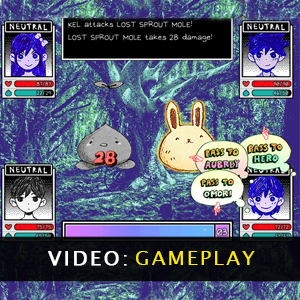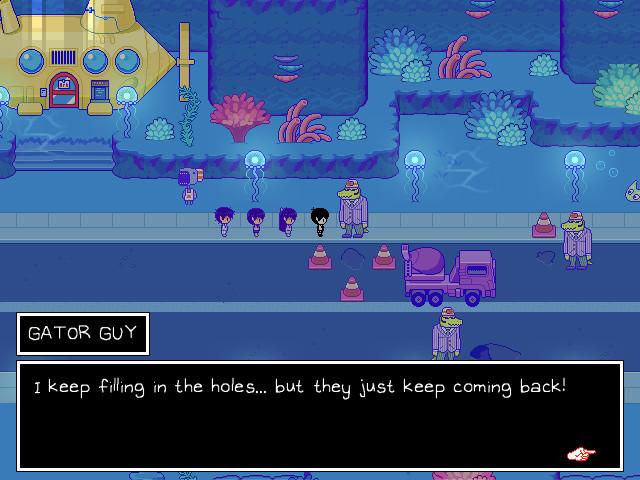Omori Steam
About This Content The soundtrack of OMORI, 179 tracks composed by Pedro Silva, Jami Lynne, and bo en. 01 Title 02 WHITE SPACE 03 Lost At A Sleepover 04 Spaces In-between 05 By Your Side. 06 Let's Get Together Now! 07 100 Sunny 08 Trouble Brewing 09 Push & Shove 10 So, How'd We Do? 11 It's Okay To Try Again 12 Trees 13 A Home For Flowers (Tulip) 14. After you download GOMORI.zip, go back to steam and browse for local files of OMORI. Open the GOMORI.zip and drag the www folder from it into the local files for OMORI. Below are the minimum and recommended system specifications for OMORI (PC) - Steam Gift - NORTH AMERICA.Due to potential programming changes, the minimum system requirements for OMORI (PC) - Steam.


Have you heard of OMORI? This indie-developed psychological horror RPG has been in development for a while despite releasing only a week ago. It was Kickstarted in 2014 and hit almost 1000% of its initial goal because people really seemed to enjoy the concept and art style created by the game’s director and artist, OMOCAT. Who knows why it took almost seven years to release on Steam with a release planned for the Nintendo Switch soon, but was it worth all that time in the oven? OMORI deserves a lot of praise for what it does get right because it really nails some parts very well, but, when it comes to others, OMORI can get tedious to play through.
STORY
OMORI’s story is great overall, but it isn’t consistent. OMORI involves finding out a story that has already happened by experiencing the results of that story throughout the game’s world, a place called the Headspace. The game is divided up into two worlds with most of the game taking place in Headspace and other parts taking place in the other world.
Sahara driver. The story and characters of the other world are interesting and felt more meaningful whereas the interactions in Headspace felt more one-dimensional. The story and characters in Headspace include things and people that connect to the more interesting other world, but, to me, Headspace didn’t really contain an interesting world by itself. The characters there didn’t really make the world seem lived in, so it didn’t make me feel compelled to talk to many of them. This was the first thing that started making the game tedious for me. I felt like I was just playing through filler episodes in Headspace to see more of the characters I wanted to see again in the other world after a certain point. The story of Headspace eventually got better as things in the other world did, but Headspace never really felt as engaging as the other world did until the very end.
GRADE: A-
The story and characters within Headspace didn’t feel as interesting to me as those of the other world did, which made the game feel inconsistent. But, the stories of both worlds came together by the end to make something really great.
PRESENTATION

The presentation in OMORI, like the story, felt great at times, but inconsistent at others. The UI was very snappy and responsive with nicely color-coded menus in battles and satisfying sound effects. The font also looks great, which is a small touch that goes a long way in a traditional RPG with so much text like this. During battles, the game looks great with OMOCAT’s stylistic visuals utilized for each party member and all the enemies you find in the game.
Outside of battle though, things didn’t look as great to me. The pixel art style looked too small to be as expressive as other indie pixel art has done, and the overworld animations looked strange at times because the sprites were so small that animating their legs or arms made it seem like their limbs were growing longer whenever they did an action. The environments looked very colorful, but, like the characters, everything felt too zoomed out, which put a lot of things on the screen at the same time. I think if everything were just a little more zoomed in and more detailed, many of these overworld problems could have been avoided. The lack of expressiveness and movement made the overworld get tedious to look at.
As for the music, there weren’t many tracks that stood out for me, but it was definitely pleasant to listen to. The sound design for more horror-based areas was really awesome, and I think those sounds are probably the most memorable parts of the music for me.
GRADE: A-
The design of the battles and UI were stylized, emotive, and satisfying to look at. The overworld left a lot to be desired, but it was alright. The music was generally nice, but the music and sounds during horror areas were amazing.


GAMEPLAY
Since it doesn’t add much to the traditional RPG formula aside from the horror, the gameplay of OMORI varies like its story and presentation. Battles are easily the most interesting and deep part of the game, and I loved what it added to the usual RPG systems. For new status effects, there are emotional effects that can be inflicted on anyone and each one has advantages or disadvantages over another in addition to changing you or your opponent’s stats. For new abilities, you can only bring four kinds of skills into battle, which requires you to switch between whichever ones you prefer using once you learn more than four. And, for something new, once you’re damaged by enemies, there are opportunities to do additional actions after your turn starts, which makes combat a little more hands-on than other turn-based RPGs.
The overworld gameplay has similar problems to the presentation, though. Besides walking, running, and interacting, you can use your party members to do different abilities. Omori can cut things, Aubrey can smash things, Kel can shoot a projectile from pedestals around the overworld, and Hero can smooth talk to characters so he can do things characters wouldn’t allow other party members to do. You need to tag out the leading party member to use each ability, which is a fun idea. Boiling the abilities down though, all of them except Kel’s were comparable to using Cut in Pokémon for me. They were not interesting to use and seemed like busy work that did not get better as I played. You receive all of them near the beginning of the game, so there wasn’t much incentive to go back to any areas and try them either. Kel’s ability was the only one that improved and allowed his to be at least a little more fun than the others since the others were just pressing the interact button in front of different objects.
Omori Steam Price
The gameplay integrates its horror aspects very very well though. In combat and the overworld, there are instances that the game teaches you how to use certain abilities and what to do when faced with certain horror elements. It reuses what it teaches you repeatedly as the game continues. In one ending of the game, it even uses one of these skills to make you do something you might not even realize has consequences. I just wish there were more of these moments throughout the game, but most are limited to the other world and almost all absent from Headspace.
Omori Steam Pfp
GRADE: A-
Its battle system finds new ways to freshen up the traditional RPG system, but its overworld takes a few steps backwards. The way it integrates its gameplay with its horror is something I have not heard of any games doing similarly before, and it is impressive.
VERDICT
OMORI has a great battle system, and the characters outside of Headspace are interesting, but the game has its problems that make parts of it very tedious. The characters in Headspace were not very deep, and the overworld’s style and gameplay both lacked detail and depth. What really integrates everything great about the game is its horror, and it’s worth playing just to experience those amazing moments integrating its horror into its gameplay.
Despite its overworld problems, its battles and horror were both awesome experiences. I loved OMORI, it was worth the wait. I’d rate it as an A-
- The Arcade-at-Home Console: exA-Arcadia - January 25, 2021
- OMORI (Steam) – The Turn-Based Fear Fighter – Review - December 31, 2020
- moon (Switch) – The Lovely Anti-RPG – Review - September 21, 2020
